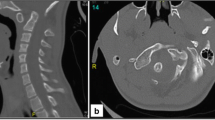Abstract
A 72-year-old male had endoscopic sinus surgery (ESS) at an outside hospital for chronic sinusitis with extensive nasal polyposis. This was complicated by an intraoperative cerebrospinal fluid (CSF leak) that was recognized at the time of surgery in addition to a transgression of the lamina papyracea. A left ethmoid cribriform defect was noted and an attempt at intraoperative repair was performed with dural matrix and fibrin sealant in addition to lumbar drain placement by Neurosurgery. Postoperatively, the patient noted horizontal diplopia as well as intermittent but persistent unilateral clear drainage. On the evening of postoperative day 2, the patient developed increased drowsiness and altered mental status. Computed tomography (CT) imaging of the brain and sinuses on postoperative day 2 demonstrated increased pneumocephalus (Fig. 12.1). High-flow oxygen delivery was started through a Venturi mask, the lumbar drain was clamped, and the patient transferred to a tertiary care hospital.
Access this chapter
Tax calculation will be finalised at checkout
Purchases are for personal use only
Similar content being viewed by others
References
Michel SJ. The Mount Fuji sign. Radiology. 2004;232(2):449–50.
Campanelli J, Odland R. Management of tension pneumocephalus caused by endoscopic sinus surgery. Otolaryngol Head Neck Surg. 1997;116(2):247–50.
Whitmore RG, Bonhomme G, Balcer LJ, Palmer JN. Tension pneumocephalus after endoscopic sinus surgery: case report of repair and management in absence of obvious skull base defect. Ear Nose Throat J. 2008;87(2):96–9.
Harvey JJ, Harvey SC, Belli A. Tension pneumocephalus: the neurosurgical emergency equivalent of tension pneumothorax. BJR Case Rep. 2016;2(2):20150127.
Yin C, Chen BY. Tension pneumocephalus from skull base surgery: a case report and review of the literature. Surg Neurol Int. 2018;9:128.
Aksoy F, Dogan R, Ozturan O, Tugrul S, Yildirim YS. Tension pneumocephalus: an extremely small defect leading to an extremely serious problem. Am J Otolaryngol. 2013;34(6):749–52.
Artru AA. Nitrous oxide plays a direct role in the development of tension pneumocephalus intraoperatively. Anesthesiology. 1982;57(1):59–61.
Pulickal G, Sitoh Y, Ng W. Tension pneumocephalus. Singapore Med J. 2014;55(3):e46–8. https://doi.org/10.11622/smedj.2014041.
Lee CH, Chen WC, Wu CI, Hsia TC. Tension pneumocephalus: a rare complication after hyperbaric oxygen therapy. Am J Emerg Med. 2009;27(2):257.e251–3.
Cohen JC, Larrabee YC, Weinstein AL, Stewart MG. Use of continuous positive airway pressure after rhinoplasty, septoplasty, and sinus surgery: a survey of current practice patterns. Laryngoscope. 2015;125(11):2612–6.
Rieley W, Askari A, Akagami R, Gooderham PA, Swart PA, Flexman AM. Immediate use of continuous positive airway pressure in patients with obstructive sleep apnea following Transsphenoidal pituitary surgery: a case series. J Neurosurg Anesthesiol. 2020;32(1):36–40.
White-Dzuro GA, Maynard K, Zuckerman SL, et al. Risk of post-operative pneumocephalus in patients with obstructive sleep apnea undergoing transsphenoidal surgery. J Clin Neurosci. 2016;29:25–8.
Ishiwata Y, Fujitsu K, Sekino T, et al. Subdural tension pneumocephalus following surgery for chronic subdural hematoma. J Neurosurg. 1988;68(1):58–61.
Biju RD, Wu J, Hussain Z. Tension pneumocephalus after skull base surgery. A case report and review of literature. J Clin Neurosci. 2020;75:218–20. https://doi.org/10.1016/j.jocn.2020.03.041.
Hong B, Biertz F, Raab P, et al. Normobaric hyperoxia for treatment of pneumocephalus after posterior fossa surgery in the semisitting position: a prospective randomized controlled trial. PLoS One. 2015;10(5):e0125710.
Church CA, Chiu AG, Vaughan WC. Endoscopic repair of large skull base defects after powered sinus surgery. Otolaryngol Head Neck Surg. 2003;129(3):204–9.
Haldar R, Khandelwal A, Gupta D, Srivastava S, Rastogi A, Singh PK. Valsalva maneuver: its implications in clinical neurosurgery. Neurol India. 2016;64(6):1276–80.
Author information
Authors and Affiliations
Corresponding author
Editor information
Editors and Affiliations
Rights and permissions
Copyright information
© 2022 Springer Nature Switzerland AG
About this chapter
Cite this chapter
Falls, M., Ting, J. (2022). Tension Pneumocephalus. In: Chandra, R.K., Welch, K.C. (eds) Lessons Learned from Rhinologic Procedure Complications. Springer, Cham. https://doi.org/10.1007/978-3-030-75323-8_12
Download citation
DOI: https://doi.org/10.1007/978-3-030-75323-8_12
Published:
Publisher Name: Springer, Cham
Print ISBN: 978-3-030-75322-1
Online ISBN: 978-3-030-75323-8
eBook Packages: MedicineMedicine (R0)




